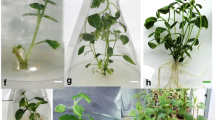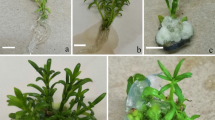Abstract
An alternative protocol was developed for in vitro propagation of photinia (Photinia × fraseri Dress), an ornamental shrub, using the plant growth-promoting rhizobacteria (PGPR) Azospirillum brasilense and Azotobacter chroococcum during rhizogenesis. Shoot tips from four-year-old mature plants, cut in spring and summer, were used as initial explants. They were cultured on Murashige–Skoog (MS) medium with Gamborg’s vitamins, N6-benzyladenine (BA: 11.1 μM) and gibberellic acid (GA3: 1.3 μM), obtaining 63% of established explants. The highest shoot length (22.9 mm) and multiplication rate (4.3) was achieved by cultivating for four weeks in the same basal medium supplemented with 4.4 μM BA. Both auxin induction and bacterial inoculation were used for rooting. Elongated shoots were treated with two concentrations of indole-3-butyric acid (IBA: 4.9 or 49.2 μM) during 6 days for auxin induction. Then, the shoots were transferred to an auxin-free medium and inoculated with A. brasilense Cd, Sp7 or A. chroococcum (local strain). Bacterial inoculation induced earlier rooting of photinia shoots. A. brasilense Cd with 49.2 μM IBA pulse showed a significant increase (P ≤ 0.05) in root fresh and dry weight (105%, 137%), root surface area (65%) and shoot fresh and dry weight (32%, 62%). A. brasilense Sp7 enhanced the root fresh weight (34%) and root surface area (41%) while no significant differences with A. chroococcum inoculation were detected. The PGPR inoculated micro-cuttings in combination with auxin induction pulses may play a useful role in root organogenesis of micropropagated plants.



Similar content being viewed by others
Abbreviations
- ATCC:
-
American Type Culture Collection
- BA:
-
N6-benzyladenine
- c.f.u.:
-
Colony forming unit
- GA3 :
-
Gibberellic acid A3
- IBA:
-
Indole-3-butyric acid
- PGPR:
-
Plant growth-promoting rhizobacteria
References
Barka EA, Belarbi A, Hachet C, Nowak J, Audran JC (2000) Enhancement of in vitro growth and resistance to gray mould of Vitis vinifera co-cultured with plant growth-promoting rhizobacteria. FEMS Microbiol Lett 186:91–95. DOI 10.1111/j.1574-6968.2000.tb09087.x
Beeson RC (2000) Putting the speed back in quick-dip auxin application. SNA Res Conf 45:298–302
Brickell C (1996) Enciclopedia de Plantas y Flores. Royal horticultural society, Grijalbo Mondadori, Verona, Italy, pp 566
Brown ME, Burlingham SK, Jackson RM (1962) Studies on Azotobacter species in soil. 1: Comparison of media and techniques for counting Azotobacter in soil. Plant Soil 17:309–313. DOI 10.1007/BF01377670
Burns JA, Schwarz OJ (1996) Bacterial stimulation of adventitious rooting on in vitro cultured slash pine (Pinus elliottii Engelm.) seedling explants. Plant Cell Rep 15:405–408. DOI 10.1007/BF00232064
Capellades-Queralt M, Beruto AM, Vanderschaeghe A, Debergh PC (1993) Ornamentals. In: Debergh PC, Zimmerman RH (eds) Micropropagation, technology and application. Kluwer, The Netherlands, pp 215–229
Carletti SM, Llorente B, Rodríguez Cáceres E, Tandecarz J (1998) Jojoba inoculation with Azospirillum brasilense stimulates in vitro root formation. Plant Tissue Cult Biotech 4:165–174
Carley HE, Watson RD (1966) A new gravimetric method for estimating root-surface areas. Soil Sci 102:289–291
Frommel M, Nowak J, Lazarovits G (1991) Growth enhancement and developmental modifications of in vitro grown potato (Solanum tuberosum spp. tuberosum) as affected by a non fluorescent Pseudomonas sp. Plant Physiol 96:928–936
Gamborg OL, Miller RA, Ojima K (1968) Nutrient requirements of suspension cultures of soybean root cells. Exp Cell Res 50:151–158. DOI 10.1016/0014-4827(68)90403-5
Kane ME, Sheehan TJ, Philman NL (1987) A micropropagation protocol using fraser photinia for mutation induction and new cultivar selection. Proc Fla State Hort Soc 100:334–337
Leifert C, Pryce S, Lumsden PJ, Waites WM (1992) Effects of medium acidity on growth and rooting of different plant species growing in vitro. Plant Cell Tiss Org Cult 30:171–179. DOI 10.1007/BF00040019
Llorente BE, Apóstolo NM (1998) Effect of different growth regulators and genotype on in vitro propagation of jojoba. New Zealand J Crop Hort Sci 26:55–62
Merkle SA, Dean JF (2000) Forest tree biotechnology. Curr Opin Biotechnol 11:298–302. DOI: 10.1016/S0958-1669(00)00099-9
Mirza MS, Ahmad W, Latif F, Haurat J, Bally R, Normand P, Mallik KA (2001) Isolation, partial characterization, and the effect of plant growth-promoting bacteria (PGPB) on micropropagated sugarcane in vitro. Plant Soil 237:47–54. DOI 10.1023/A:1013388619231
Modgil M, Sharma DR, Bhardwaj SV (1999) Micropropagation of apple cv. Tydeman’s Early Worcester Sci Hort 81:179–188. DOI 10.1016/S0304-4238(98)00259-3
Murashige T, Skoog F (1962) A revised medium for rapid growth and bioassays with tobacco tissue culture. Physiol Plant 15:473–497
Nowak J, Shulaev J (2003) Priming for transplant stress resistance in in vitro propagation. In Vitro Cell Dev Biol Plant 39:107–124. DOI 10.1079/IVP2002403
Nowak J (1998) Benefits of in vitro “biotization” of plant tissue cultures with microbial inoculants. In Vitro Cell Dev Biol Plant 34:122–130
Okon Y, Albrecht SL, Burris RH (1977) Methods for growing Spirillum lipoferum and for counting it in pure culture and in association with plants. Appl Environ Microbiol 33:85–88
Okon Y, Vanderleyden J (1997) Root-associated Azospirillum species can stimulate plants. ASM News 63:366–370
Ramírez-Malagón R, Borodanenko A, Barrera-Guerra J, Ochoa-Alejo N (1997) Micropropagation for fraser photinia (Photinia × fraseri). Plant Cell Tiss Org Cult 48:219–222. DOI 10.1023/A:1005898106134
Shetty K, Carpenter TL, Curtis OF, Potter TL (1996) Reduction of hyperhydricity in tissue cultures of oregano (Origanum vulgare) by extracellular polysaccharide isolated from Pseudomonas spp. Plant Sci 120:175–183. DOI 10.1016/S0168-9452(96)04482-2
Shibli RA, Ajlouni MM, Jaradat A, Aljanabi S, Sharnawi M (1997) Micropropagation in wild pear (Pyrus syrica). Sci Hort 68:237—242. DOI 10.1016/S0304-4238(96)00972-7
Vestberg M, Kukkonen S, Saari K, Parikka P, Huttunen J, Tainio L, Devos N, Weekers F, Kevers C, Thonart P, Lemoine MC, Cordier C, Alabouvette C, Gianinazzi S (2004) Microbial inoculation for improving the growth and health of micropropagated strawberry. Appl Soil Ecol 27:243–258. DOI 10.1016/j.apsoil.2004.05.006
von Aderkas P, Bonga JM (2000) Influencing micropropagation and somatic embryogenesis in mature trees by manipulation of phase change, stress and culture environment. Tree Physiol 20:921–928
Zimmerman RH, Jones JB (1991) Commercial micropropagation in North America. In: Debergh PC, Zimmerman RH (eds) Micropropagation. Kluwer, The Netherlands, pp 173–179
Acknowledgements
The authors thank Lic. Susana Filippini from Statistical Division, National University of Luján, for providing statistical advice. This research was supported by a grant from the Department of Basic Sciences, National University of Luján, Argentina.
Author information
Authors and Affiliations
Corresponding author
Additional information
Communicated by H. S. Judelson
Rights and permissions
About this article
Cite this article
Larraburu, E.E., Carletti, S.M., Rodríguez Cáceres, E.A. et al. Micropropagation of photinia employing rhizobacteria to promote root development. Plant Cell Rep 26, 711–717 (2007). https://doi.org/10.1007/s00299-006-0279-2
Received:
Revised:
Accepted:
Published:
Issue Date:
DOI: https://doi.org/10.1007/s00299-006-0279-2




